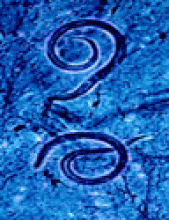Strongyloides infection in Canada
Figure. Photo by: Cecil H. Fox / Science Photo Library
Strongyloidiasis, an infectious disease caused by the nematode Strongyloides stercoralis, is endemic in Africa, Southeast Asia, and Central and South America. Lim and colleagues suspect that strongyloidiasis may be more frequent in Canada today because over three-quarters of immigrants to Canada arrive from Strongyloides-endemic areas. Diagnosis may be delayed because physicians in Canada may be unfamiliar with the disease, which has a wide range of nonspecific clinical manifestations. Patients with suppressed cellular immunity are at highest risk of disseminated infection, which has a high rate of death. Since the outcome of strongyloidiasis depends largely on timely diagnosis and therapy, screening for this infection should be considered in every person who has compatible symptoms and a history of travel to or residence in disease-endemic areas and risk factors for disseminated disease.
See page 479
Is Clostridium difficile-associated diarrhea becoming more severe?
Pépin and colleagues found in a retrospective chart review at their institution that the incidence of Clostridium difficile-associated diarrhea (CDAD) among patients aged 65 years or more increased 10-fold between 1991 and 2003, while the case-fatality rate more than doubled. Several factors may have contributed to this epidemic among elderly patients: the increased age of inpatients, their more numerous comorbidities, inadequate hygiene in hospitals and the possible development of a more virulent strain of C. difficile. CDAD is usually treated first with metronidazole, but the lower risk of progression to complicated CDAD among patients who first received vancomycin deserves further investigation.
See page 466
Varying appropriateness of carotid endarterectomy
Carotid endarterectomy (CE) is an efficient way to prevent stroke in patients who have an appropriate indication for the procedure. Although the guidelines for surgery are clear, Kennedy and colleagues found that CE rates in Canadian hospitals vary and that in only half of cases are the indications appropriate. Higher rates of CE in their study were associated with lower rates of appropriateness for surgeons and hospitals and, overall, 1 in 10 CEs was inappropriate. However, in a related commentary, Barnett points out that perioperative complications of stroke and death, which are more frequent among low-volume surgeons and low-volume hospitals, also have to be taken into account, since they may counteract the benefits of appropriate selection of patients.
Socioeconomic status and receipt of colorectal cancer investigation
The Canadian health care system is designed to ensure equal access to all. However, it does not always work that way in practice. Singh and colleagues found inequities in the receipt of colorectal cancer investigations that were associated with socioeconomic status: people with a higher income had higher odds of receiving any such investigation. Whether these variations affect rates of death from colorectal cancer remains to be explored.
See page 461
In Synopsis
Campana describes the use of telemedicine for an emergency craniotomy in a 10-year-old girl (page 444), Kurdyak reviews a study that investigates whether food additives cause hyperactivity in preschool children (page 450), and Weir warns that there may still be more questions about bacterial vaginosis than answers (page 448).













